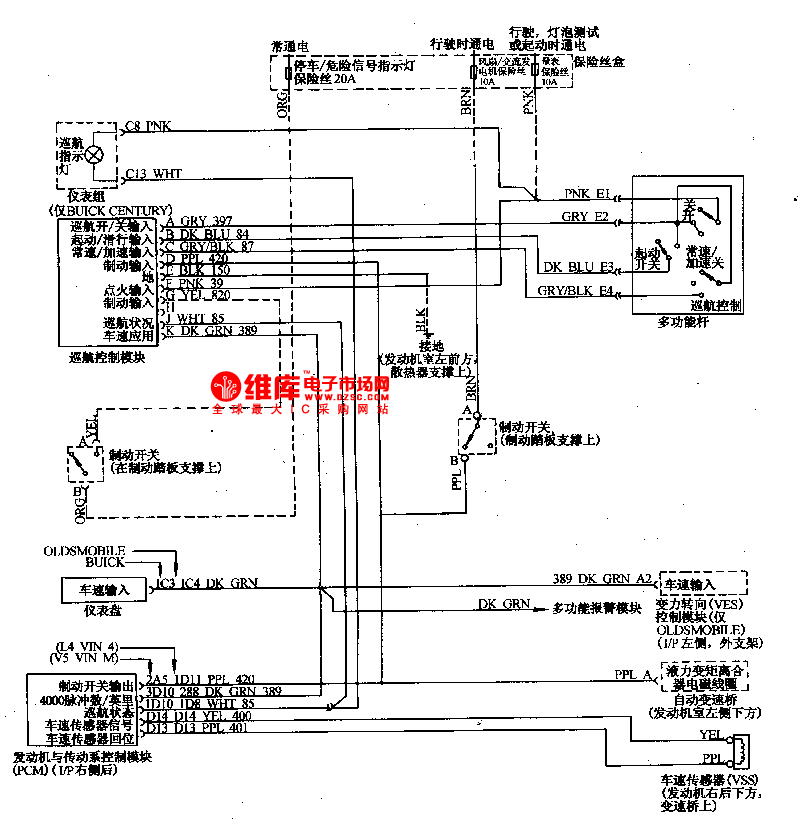The cruise system is generally composed of a cruise control switch, a vehicle speed sensor, a cruise control ECU, an actuator, and a brake switch. When cruising driving (constant speed driving) is required, the driver sends a command signal such as "fixed speed", "acceleration", "deceleration", "recovering the original speed" and "cancel" to the cruise ECU through the cruise control switch. When the commander sets the commanded vehicle speed, the commanded vehicle speed signal and the actual vehicle speed feedback signal are simultaneously input into the cruise ECU. After the comparison operation is amplified and compensated, the ECU outputs a throttle control signal to the actuator, and changes the section when the resistance changes. The opening of the valve keeps the speed constant.

Cruise control switches are typically installed on the steering column where the driver can easily reach. There are often three gear positions: "SET/COAST", "Cancel" (CANCEL and "Reset/Acceleration" (RES/ACC) .
When the switch is placed in the "Set/Cruise" position, the vehicle will continue to accelerate as long as the button is pressed. When the required speed is reached, the button is released and the cruise system will follow the speed at which the button is released. Keep driving at a constant speed.
When the switch is switched to the "cancel" position, the constant speed driving state is released and the throttle valve returns to the idle state.
If the vehicle has been braking, shifting or hanging in the process of driving, the cruise control state will be canceled. If you want to resume the cruise state, put the switch in the "reset/acceleration" block and the vehicle will re-accelerate to the last setting. The speed of the car is running at a constant speed.
The vehicle speed sensor signal is often taken from the speedometer of the instrument panel, and the vehicle speed sensor dedicated to cruise control is generally mounted on the transmission output shaft.
The function of the actuator is to accept the control command of the cruise ECU, electrically or pneumatically operate the throttle valve, change the throttle opening degree, and then the vehicle accelerates, decelerates and travels at a constant speed. The electric actuator may be controlled by the electric motor plus the electromagnetic clutch plus the position sensor to control the throttle opening degree; or the stepping motor may be used to control the throttle opening degree, and the opening degree of the throttle valve is determined by the pulse phase sequence assigned by the ECU. Vacuum actuators mainly rely on the vacuum box diaphragm to control the throttle opening, while the vacuum inside the vacuum box is operated by the engine intake manifold vacuum, but it is controlled by the vacuum solenoid valve and the air solenoid valve. When accelerating, the ECU opens the vacuum electric valve, and the vacuum box communicates with the intake manifold; the air solenoid valve closes, the vacuum suctions the diaphragm, the diaphragm pulls the throttle opening to increase, and the car accelerates.
When the car accelerates to a certain speed, the ECU closes the vacuum solenoid valve and the air solenoid valve at the same time, and the vacuum degree in the vacuum box does not change, that is, the constant speed travels. When the car decelerates, the ECU turns off the air solenoid valve to open, the air enters the vacuum box, the throttle opening decreases, and the car decelerates.
In the figure, the actuator is not seen, only the "cruise condition" of the ECU is output to the signal line of the engine and the transmission control computer, but in the cruise control circuit of the Lumina bullet wagon produced by General Motors Chevrolet, The actuator is vacuum type, and there are vacuum solenoid valves and bleed solenoid valves (air solenoid valves) for reference.
B85 8-card mainboard, 8-card in-line motherboard platform (B85 8-card 1820U independent U+ new chassis 4 strong 5300 RPM fan /4 silent 3000 RPM optional +4G memory +128G solid state +2000W new power supply) compatible with all types of graphics cards in the market, stable performance, reasonable heat dissipation.
X79 Gpu Mining Case
Chassis weight: 4.5kg
Weight of chassis with fan: 5.5kg
Size:500*400*180mm
Multi graphics card case custom case
Motherboard bit: compatible with standard ATX motherboard
Hard disk bit: a 3.5-inch hard disk or a 2.5-inch hard disk
Power bit: ATX power installation size
Standard fan: 4 sets of 12038 fans,
Graphics card bit: supports up to 5 330mm long graphics cards
Chassis material: 1.0 mm cold plate full baking paint to prevent rust, anti-static effect!
tips: chassis products are bulky, heavy weight, and the express freight is very expensive. Buyers should consider buying them carefully to avoid unnecessary loss caused by return. If you don't understand, please communicate with customer service.
The fan of the product is double ball fan, 5300 RPM new violent fan, with noise of 65dB
B85 Gpu Case,B75 gpu case,gpu mining case,gpu case,GPU Server Case
Shenzhen YLHM Technology Co., Ltd. , https://www.apgelectrical.com